| An Introduction to Single-Line Block Working |
|||
|
This is an Introduction page about the various methods of Single-Line Block Working used on single-line railways in the UK West Country. Details of the actual systems used on individual sections are listed in a separate RailWest Register of Single-Line Sections.
It is not intended to provide a detailed description of the actual method of operation of the different forms of single-line block working, as that subject will be covered elsewhere. Some information on single-line control instruments can be found in The Signal Box website and it is hoped to include more details in RailWest in due course. The information on this page will provide a background to the details set out in other RailWest pages. Most of the railways in the West Country eventually became part of either the London & South Western Railway (L&SWR) (later the Southern Railway (SR)) or the Great Western Railway (GWR), so this page will concentrate primarily on those two companies, but parts of it will be relevant also to the various other minor independent lines.
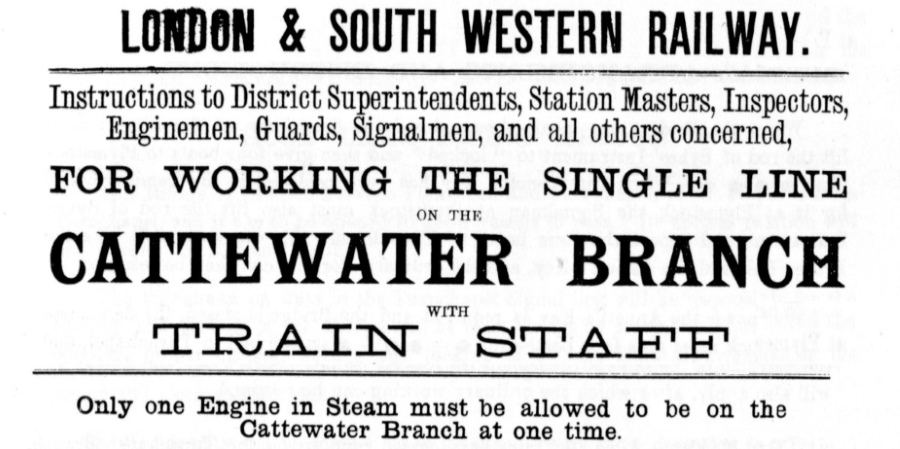
From about the mid-1870s until the mid-1890s most (but by no means all) single-line block sections in the West Country were controlled by the "Train Staff and Ticket" (TS&T) method. There were a number of One Engine in Steam (OES) sections, mostly on goods-only lines, but some minor passenger branch lines reverted to that system in later years and it became quite common on 'rationalised' dead-end branches in British Railways (BR) days. Train staffs were usually made of wood or metal in a variety of styles and would be labelled with the identity of the section to which they applied (usually the names of the signal-boxes at each end of the section); any 'tickets' would be card or paper (occasionally metal) and pre-printed with the section details.

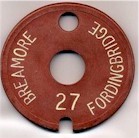 After the invention of the Electric Train Tablet
(ETT) system by Edward Tyer in 1878 the L&SWR eventually adopted ETT as their
standard for new works, as well as fitting it retrospectively in due course to all their existing
West Country sections. Under their influence ETT was applied gradually also to the Somerset & Dorset Joint Railway
(S&DJR) from 1885 onwards, although one S&DJR section did remain as TS&T until
BR days. Both the L&SWR and S&DJR used a variety of different versions of Tyer's
ETT instruments. Tablets originally were made from brass, or steel with an inset
brass face-plate, but in later years a hard red fibre was used; a few examples
were made from aluminium alloy.
After the invention of the Electric Train Tablet
(ETT) system by Edward Tyer in 1878 the L&SWR eventually adopted ETT as their
standard for new works, as well as fitting it retrospectively in due course to all their existing
West Country sections. Under their influence ETT was applied gradually also to the Somerset & Dorset Joint Railway
(S&DJR) from 1885 onwards, although one S&DJR section did remain as TS&T until
BR days. Both the L&SWR and S&DJR used a variety of different versions of Tyer's
ETT instruments. Tablets originally were made from brass, or steel with an inset
brass face-plate, but in later years a hard red fibre was used; a few examples
were made from aluminium alloy.
By contrast the GWR adopted the Electric Train Staff (ETS) system and they deployed this extensively throughout their network. ETS had been devised originally in 1888 by Messrs Webb and Thompson (of the London & North Western Railway) and licenced to the Railway Signal Company, although the GWR used an improved version patented in 1890. This equipment is sometimes called the 'large' ETS to distinguish it from a smaller 'miniature' ETS system developed later by the Railway Signal Company. Each staff was a steel tube, usually about 23" long, with a number of brass rings, so quite a substantial item; the names of the signal-boxes between which it applied were embossed on brass plates fixed on opposite sides of the tube at one end.

About 1908 the GWR adopted the Tyer's No 7 pattern of ETT as their standard instrument instead of ETS, but in the event only a few sections were fitted with this equipment before there was a further change of policy.
 In 1912 GWR
engineers Blackall and Jacobs invented the Electric Key
Token (EKT) system and thereafter the GWR used EKT for new work
and the replacement of old equipment. The GWR also licensed their EKT system
to Tyer, who then manufactured EKT equipment for other railways (usually
with variations in design). Early GWR tokens were made from steel, with the signal-box
names either embossed or engraved on a brass plate which was
rivetted to the face of the handle; later tokens were made from an aluminium
alloy and the signal-box names were engraved directly into the face of the
handle.
In 1912 GWR
engineers Blackall and Jacobs invented the Electric Key
Token (EKT) system and thereafter the GWR used EKT for new work
and the replacement of old equipment. The GWR also licensed their EKT system
to Tyer, who then manufactured EKT equipment for other railways (usually
with variations in design). Early GWR tokens were made from steel, with the signal-box
names either embossed or engraved on a brass plate which was
rivetted to the face of the handle; later tokens were made from an aluminium
alloy and the signal-box names were engraved directly into the face of the
handle.
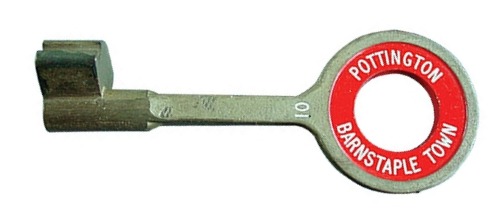 In later years the Southern
Railway (SR), and then BR Southern Region (BR(SR)), used
Tyer's EKT as a replacement on several ETT sections, although their style of
token varied from the pattern used by the GWR and BR Western Region (BR(WR)). However in the West Country
most (but not all) examples of EKT equipment on former SR lines were fitted
in fact after 1948 by BR(WR) using the ex-GWR pattern. SR tokens were
made from a variety of materials such as steel, bronze or aluminium alloy, with
the names of the signal-boxes engraved in the face of the handle.
In later years the Southern
Railway (SR), and then BR Southern Region (BR(SR)), used
Tyer's EKT as a replacement on several ETT sections, although their style of
token varied from the pattern used by the GWR and BR Western Region (BR(WR)). However in the West Country
most (but not all) examples of EKT equipment on former SR lines were fitted
in fact after 1948 by BR(WR) using the ex-GWR pattern. SR tokens were
made from a variety of materials such as steel, bronze or aluminium alloy, with
the names of the signal-boxes engraved in the face of the handle.
Some other varieties of single-line control also existed in the West Country, such as a few sections of 'No Signalman' Key Token (NSKT) working, and a solitary example of the Railway Signal Company's Miniature ETS ('M' type). There were also a few examples of 'long section' working, where an intermediate signal-box could be 'switched out' and the two 'short' sections on either side of it worked as a single 'long' section, and sometimes different control systems were used for the 'long' and 'short' sections. In later years also there were examples of block control systems which dispensed with the need for physical staffs, tablets or tokens altogether, such as Acceptance Lever working and Tokenless Block, but these are outside of the scope of this page.
Wherever there were two or more adjacent sections of single-line worked by some form of staff, tablet or token then it was vital to ensure that the driver of a train entering a section was not given the wrong staff/tablet/token by mistake - with potentially disastrous results. Apart from the driver being required to satisfy himself that he had the correct item before entering the section, a further safeguard was provided by what is known usually as the 'configuration' of the staff/tablet/token. [The term 'configuration' probably only applies really to the various 'electric' systems - ie ETT, ETS and EKT - but a similar principle applied to the 'manual' OES and TS&T systems.] Configuration information for individual sections (where known) is included in the RailWest Register.
For the 'manual' OES and TS&T systems the 'configuration' was achieved usually by one or both of two methods, namely the colour of the train staff and the shape of its cross-section. Colour was used for visual identification in daylight, whilst the cross-section shape enabled the staff to be identified by touch at night. Typical examples of staff configuration might be "round, red" or "square, blue" etc. In all cases the staff would be labelled with the identity of the section to which it applied, usually the names of the signal-boxes at each end of the section. In the case of TS&T the tickets themselves might also be of the same colour and/or shape as the relevant staff, although on some sections different colours were used for the tickets for 'Up' and 'Down' directions.
For the 'electric' ETT, ETS and EKT systems the 'configuration' was achieved by some aspect of the mechanical form of the staff/tablet/token, usually the position and/or shape of a notch or ring. The purpose of this aspect of the configuration was to prevent the staff/tablet/token being replaced into the wrong instrument after use. Sometimes there was also a variation in shape and/or the use of different colours and this provided visual identification of the correct item. In all cases again the staff/tablet/token would bear the idendity of the section to which it applied, usually the names of the signal-boxes at each end of the section. Sometimes also the individual staffs/tokens/tablets for any given section were numbered (from 1 upwards), but this numbering played no part in the actual operation of the system.
Generally the configurations for the different types of ETS, ETT and EKT equipments were standardised and identified by letter:- 'A', 'B', 'C', 'D' (configuration 'D' appears to have been very rare with ETS and ETT). In some cases this letter was engraved on the item itself and/or the instrument in which it was kept, although this appears to have been a practice mostly confined to ETS (both 'large' and 'miniature' versions).
Most Tyer's tablets were circular, although their diameter varied depending upon the particular model of instrument. [Although Tyer did manufacture square tablets for use with 'long section' working, no examples are known to have existed in the West Country; however there was one 'long section' on the S&DJR which used 'square tablet' instruments supplied by McKenzie & Holland.] For visual identification each tablet had a large central hole of a specific shape associated with its configuration:- Round (A), Square (B), Triangular (C), Diamond (D).
| Examples of Electric Train Tablet Configurations | |||
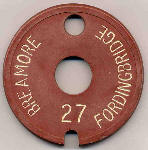 |
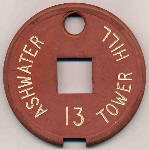 |
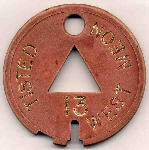 |
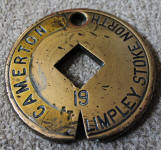 |
| Configuration 'A' | Configuration 'B' | Configuration 'C' | Configuration 'D' |
| Round centre hole Round notch in edge |
Square centre hole Rectangular notch |
Triangular centre hole Combined rectangular + long round notch |
Diamond centre hole 'V' notch in edge |
|
NOTE: In the 'C' configuration tablet the left-hand rectangular notch is NOT part of the normal configuration. The 'A' 'B' and 'C' tablets are SR No 6 ETT, the 'D' tablet is GWR No 7 ETT. The small circular hole seen at the top of each tablet was not part of any configuration, but provided probably to enable the signalman to remove the tablet from the drawer of the instrument. |
|||
For the large ETS there was a colour code associated with each configuration, which on the GWR was as follows:- Red (A), Blue (B), Green (C), Yellow (D). It would appear that in most cases the paint was applied only to the end of the staff with the nameplates, but some staffs may have been painted over their full length. It is not known if the SR ever painted their Miniature ETS staffs.
|
|
SR/BR(SR) key-tokens used the same shapes as the central holes in tablets for visual distinction of the configurations by the shape of the handle and/or a hole in the centre of the handle. Some patterns of tokens also had a colour code, but while some used the same sequence as ETS others used a different sequence. GWR/BR(WR) key tokens merely had a plain rectangular handle painted in the appropriate colour.
| Examples of SR/BR(SR) Electric Key Tokens | |||
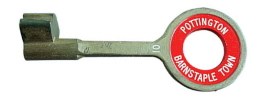 |
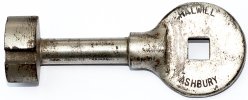 |
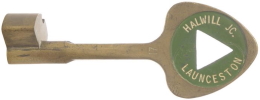 |
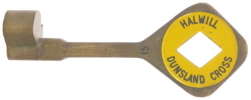 |
| Configuration 'A' | Configuration 'B' | Configuration 'C' | Configuration 'D' |
| Examples of GWR/BR(WR) Electric Key Tokens | |||
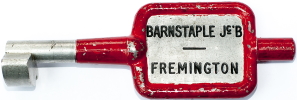 |
 |
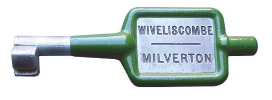 |
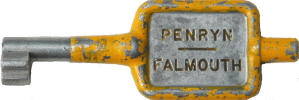 |
| Configuration 'A' | Configuration 'B' | Configuration 'C' | Configuration 'D' |
© CJL Osment 2014-20
ETS and Carbean staff photographs © David Hayball, 'D' tablet photograph © Gordon Marshall,
other images WCRA collection.